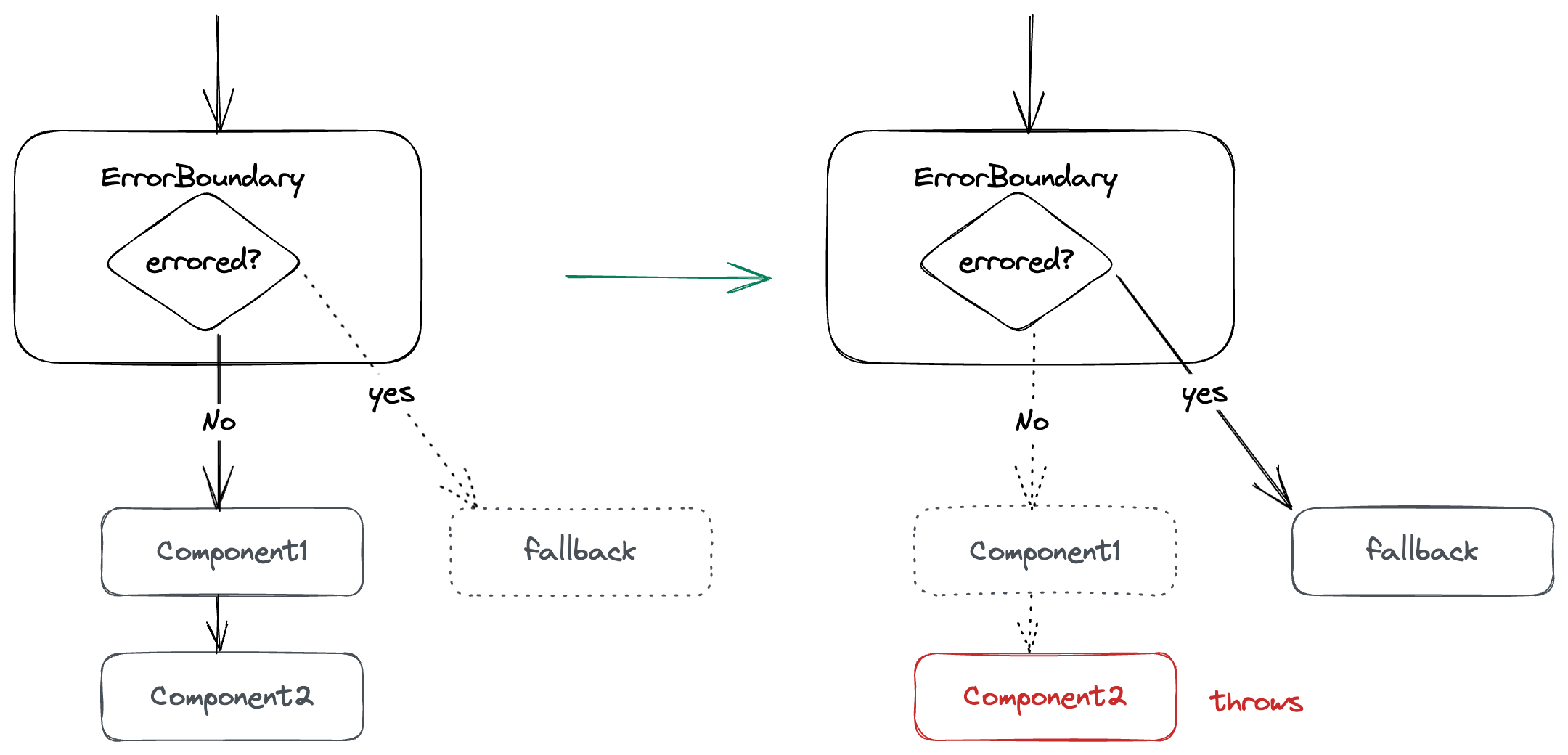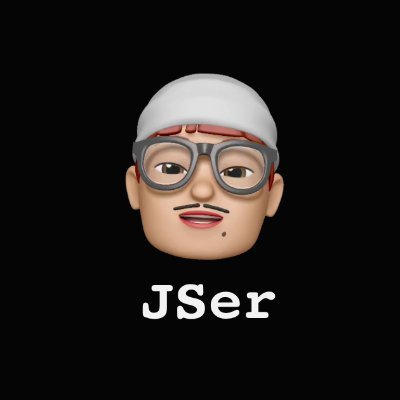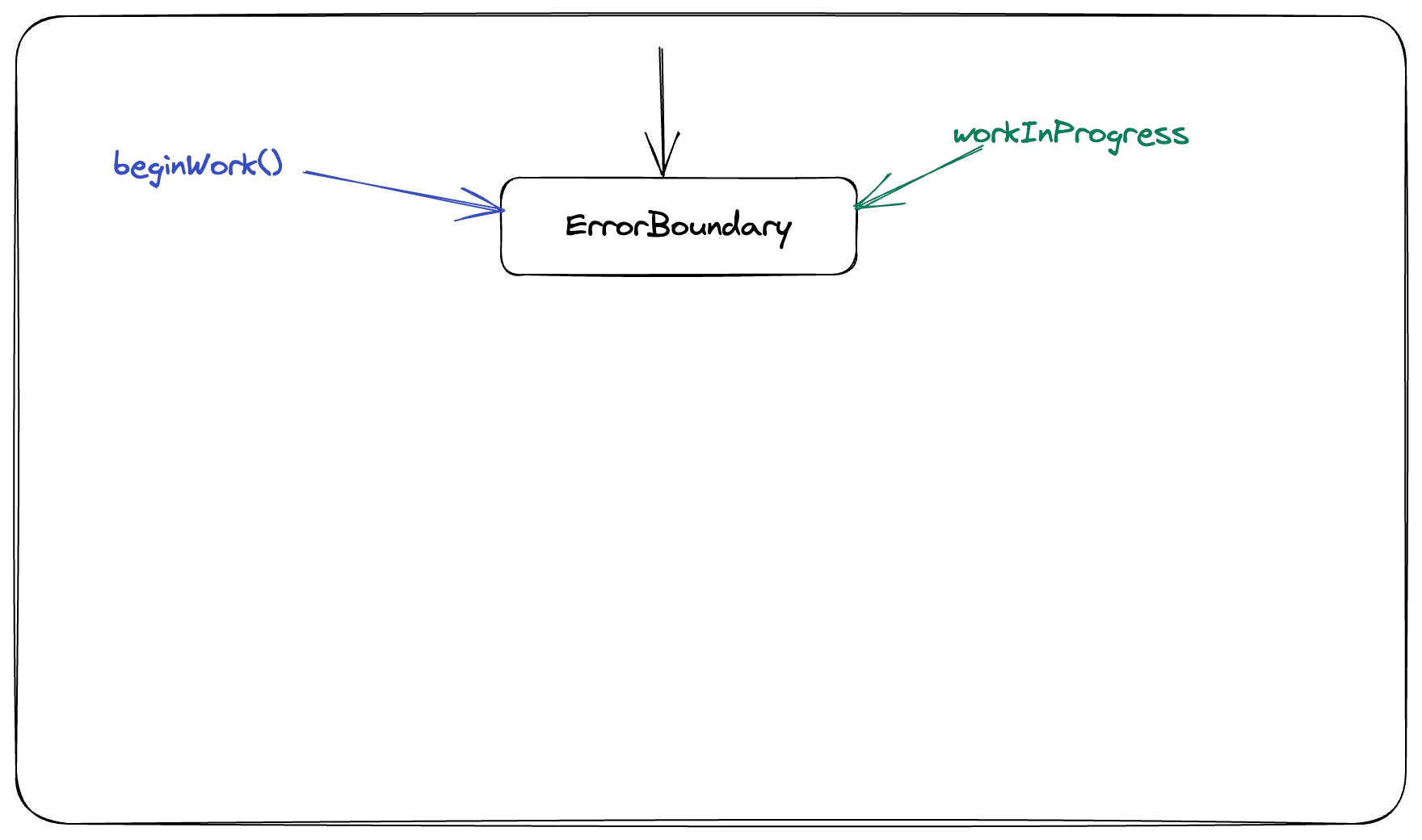How does ErrorBoundary work internally in React?
1. ErrorBoundary is a declarative try…catch for React fiber tree
jsx
jsx
If Profile throws in rendering, ErrorBoundary will try to render the fallback, as explained in How does React traverse Fiber tree internally,
the rendering order of fiber nodes will be like below.

Any Class Component that implements static getDerivedStateFromError(error) is an ErrorBoundary.
2. How does ErrorBoundary work internally?
2.1 When an error is thrown, closest ErrorBoundary is marked with flag: ShouldCapture and scheduled with state update.
Either for Sync mode or Concurrent mode, a big try...catch is applied for the work loop, and handleError() handles the thrown values.
workLoopConcurrent(), in which it constantly checks if it needs to yield to main thread. Explained in How React Scheduler works?
handleError() internally throws and start completing the work on the fiber node. As explained in
How does React traverse Fiber tree internally?, since
error is thrown we don’t need to go down to children any furthur, we should start complete() phase.
This InComplete flag is imporant for completeUnitOfWork()
if (value !== null &&typeof value === 'object' &&typeof value.then === 'function') {this branch is for Suspense
...} else {this branch is for normal error boundary
...value = createCapturedValueAtFiber(value, sourceFiber);renderDidError(value);let workInProgress: Fiber = returnFiber;do {This do...while loop searches for the closest error boundary along the path to root
switch (workInProgress.tag) {case HostRoot: {...}case ClassComponent:--------------// Capture and retryconst errorInfo = value;const ctor = workInProgress.type;const instance = workInProgress.stateNode;if ((workInProgress.flags & DidCapture) === NoFlags &&(typeof ctor.getDerivedStateFromError === 'function' ||~~~~~~~~~~~~~~~~~~~~~~~~We found a boundary!
(instance !== null &&typeof instance.componentDidCatch === 'function' &&!isAlreadyFailedLegacyErrorBoundary(instance)))) {workInProgress.flags |= ShouldCapture;-------------ShouldCapture will turn into DidCapture soon
const lane = pickArbitraryLane(rootRenderLanes);workInProgress.lanes = mergeLanes(workInProgress.lanes, lane);// Schedule the error boundary to re-render using updated stateconst update = createClassErrorUpdate(This error boundary needs to handle error now, so schedules an update on it
workInProgress,errorInfo,lane,);enqueueCapturedUpdate(workInProgress, update);~~~~~~~~~~~~~~~~~~~~~~~~~~~~~~~~~~~~~~~~~~~~~return;}break;default:break;}// $FlowFixMe[incompatible-type] we bail out when we get a nullworkInProgress = workInProgress.return;} while (workInProgress !== null);}
This InComplete flag is imporant for completeUnitOfWork()
if (value !== null &&typeof value === 'object' &&typeof value.then === 'function') {this branch is for Suspense
...} else {this branch is for normal error boundary
...value = createCapturedValueAtFiber(value, sourceFiber);renderDidError(value);let workInProgress: Fiber = returnFiber;do {This do...while loop searches for the closest error boundary along the path to root
switch (workInProgress.tag) {case HostRoot: {...}case ClassComponent:--------------// Capture and retryconst errorInfo = value;const ctor = workInProgress.type;const instance = workInProgress.stateNode;if ((workInProgress.flags & DidCapture) === NoFlags &&(typeof ctor.getDerivedStateFromError === 'function' ||~~~~~~~~~~~~~~~~~~~~~~~~We found a boundary!
(instance !== null &&typeof instance.componentDidCatch === 'function' &&!isAlreadyFailedLegacyErrorBoundary(instance)))) {workInProgress.flags |= ShouldCapture;-------------ShouldCapture will turn into DidCapture soon
const lane = pickArbitraryLane(rootRenderLanes);workInProgress.lanes = mergeLanes(workInProgress.lanes, lane);// Schedule the error boundary to re-render using updated stateconst update = createClassErrorUpdate(This error boundary needs to handle error now, so schedules an update on it
workInProgress,errorInfo,lane,);enqueueCapturedUpdate(workInProgress, update);~~~~~~~~~~~~~~~~~~~~~~~~~~~~~~~~~~~~~~~~~~~~~return;}break;default:break;}// $FlowFixMe[incompatible-type] we bail out when we get a nullworkInProgress = workInProgress.return;} while (workInProgress !== null);}
Inside the update is where getDerivedStateFromError() is called actually.
And enqueueCapturedUpdate() sets the update to updateQueue of the errored fiber,
then processUpdateQueue() inside mountClassInstance() and updateClassInstance(),
makes sure they are processed for next render.
These are some details for Class Components, which is old-age stuff, we won’t cover them in details here, just remmeber that after this, the closest error boundary will have a new state reflecting the error for its next render.
2.2 flag:ShouldCapture is changed to flag:DidCapture during unwinding
In How does Context work internally in React?, I’ve mentioned that React runtime stores a lot of info along the path, which means cleanup work for each fiber is critical to not mess things up.
In throwException() we searched for the closest ErrorBoundary, but we haven’t move the current cursor
of fiber tree to that boundary yet. Unwinding is such process - go backward to the closest error boundary
and try re-render from there.
And unwinding happens inside completeUnitOfWork(), which we mentioned earlier in this post.
See why Incomplete flag is important here
Branch below is normal branch
let next;if (!enableProfilerTimer ||(completedWork.mode & ProfileMode) === NoMode) {next = completeWork(current, completedWork, subtreeRenderLanes);} else {startProfilerTimer(completedWork);next = completeWork(current, completedWork, subtreeRenderLanes);// Update render duration assuming we didn't error.stopProfilerTimerIfRunningAndRecordDelta(completedWork, false);}resetCurrentDebugFiberInDEV();if (next !== null) {// Completing this fiber spawned new work. Work on that next.workInProgress = next;return;}} else {Here is Incomplete branch, where we need to unwind
// This fiber did not complete because something threw. Pop values off// the stack without entering the complete phase. If this is a boundary,// capture values if possible.const next = unwindWork(current, completedWork, subtreeRenderLanes);// Because this fiber did not complete, don't reset its lanes.if (next !== null) {This branch shows us that if completeWork() returns a fiber node,
React will re-render from that node, rather than continue completeWork() on parent
// If completing this work spawned new work, do that next. We'll come// back here again.// Since we're restarting, remove anything that is not a host effect// from the effect tag.next.flags &= HostEffectMask;workInProgress = next;return;}if (returnFiber !== null) {// Mark the parent fiber as incomplete and clear its subtree flags.returnFiber.flags |= Incomplete;All ancester nodes of InComplete fiber nodes are all InComplete.
This makes sure closest ErrorBoundary is InComplete,
so that unwindWork() will be called against the boundary
returnFiber.subtreeFlags = NoFlags;returnFiber.deletions = null;} else {// We've unwound all the way to the root.workInProgressRootExitStatus = RootDidNotComplete;workInProgress = null;return;}}const siblingFiber = completedWork.sibling;if (siblingFiber !== null) {// If there is more work to do in this returnFiber, do that next.workInProgress = siblingFiber;return;}// Otherwise, return to the parentcompletedWork = returnFiber;// Update the next thing we're working on in case something throws.workInProgress = completedWork;} while (completedWork !== null);// We've reached the root.if (workInProgressRootExitStatus === RootInProgress) {workInProgressRootExitStatus = RootCompleted;}}
See why Incomplete flag is important here
Branch below is normal branch
let next;if (!enableProfilerTimer ||(completedWork.mode & ProfileMode) === NoMode) {next = completeWork(current, completedWork, subtreeRenderLanes);} else {startProfilerTimer(completedWork);next = completeWork(current, completedWork, subtreeRenderLanes);// Update render duration assuming we didn't error.stopProfilerTimerIfRunningAndRecordDelta(completedWork, false);}resetCurrentDebugFiberInDEV();if (next !== null) {// Completing this fiber spawned new work. Work on that next.workInProgress = next;return;}} else {Here is Incomplete branch, where we need to unwind
// This fiber did not complete because something threw. Pop values off// the stack without entering the complete phase. If this is a boundary,// capture values if possible.const next = unwindWork(current, completedWork, subtreeRenderLanes);// Because this fiber did not complete, don't reset its lanes.if (next !== null) {This branch shows us that if completeWork() returns a fiber node,
React will re-render from that node, rather than continue completeWork() on parent
// If completing this work spawned new work, do that next. We'll come// back here again.// Since we're restarting, remove anything that is not a host effect// from the effect tag.next.flags &= HostEffectMask;workInProgress = next;return;}if (returnFiber !== null) {// Mark the parent fiber as incomplete and clear its subtree flags.returnFiber.flags |= Incomplete;All ancester nodes of InComplete fiber nodes are all InComplete.
This makes sure closest ErrorBoundary is InComplete,
so that unwindWork() will be called against the boundary
returnFiber.subtreeFlags = NoFlags;returnFiber.deletions = null;} else {// We've unwound all the way to the root.workInProgressRootExitStatus = RootDidNotComplete;workInProgress = null;return;}}const siblingFiber = completedWork.sibling;if (siblingFiber !== null) {// If there is more work to do in this returnFiber, do that next.workInProgress = siblingFiber;return;}// Otherwise, return to the parentcompletedWork = returnFiber;// Update the next thing we're working on in case something throws.workInProgress = completedWork;} while (completedWork !== null);// We've reached the root.if (workInProgressRootExitStatus === RootInProgress) {workInProgressRootExitStatus = RootCompleted;}}
And in unwindWork(), flag DidCapture comes into play.
See that ShouldCapture is turned into DidCapture
return workInProgress;As explained before this, this returning means React re-renders from this fiber,
which is the closest boundary
}return null;}...}}
See that ShouldCapture is turned into DidCapture
return workInProgress;As explained before this, this returning means React re-renders from this fiber,
which is the closest boundary
}return null;}...}}
2.3 flag:DidCapture in ErrorBoundary enforces re-rendering with new children
For this time, render() will return different children,
because of the scheduled update created when error is thrown.
}// React DevTools reads this flag.workInProgress.flags |= PerformedWork;if (current !== null && didCaptureError) {// If we're recovering from an error, reconcile without reusing any of// the existing children. Conceptually, the normal children and the children// that are shown on error are two different sets, so we shouldn't reuse// normal children even if their identities match.forceUnmountCurrentAndReconcile(its name and the comments above it says everything
current,workInProgress,nextChildren,renderLanes,);} else {reconcileChildren(current, workInProgress, nextChildren, renderLanes);}return workInProgress.child;Continue reconciling by going deeper to the children
}
For this time, render() will return different children,
because of the scheduled update created when error is thrown.
}// React DevTools reads this flag.workInProgress.flags |= PerformedWork;if (current !== null && didCaptureError) {// If we're recovering from an error, reconcile without reusing any of// the existing children. Conceptually, the normal children and the children// that are shown on error are two different sets, so we shouldn't reuse// normal children even if their identities match.forceUnmountCurrentAndReconcile(its name and the comments above it says everything
current,workInProgress,nextChildren,renderLanes,);} else {reconcileChildren(current, workInProgress, nextChildren, renderLanes);}return workInProgress.child;Continue reconciling by going deeper to the children
}
The code is pretty straightforward.
3. Summary
Now let’s summarize what we’ve learned with some diagrams.
4. Coding Challenge
Try out following coding quiz to enhance what we’ve learned today.

Want to know more about how React works internally?
Check out my series - React Internals Deep Dive!

